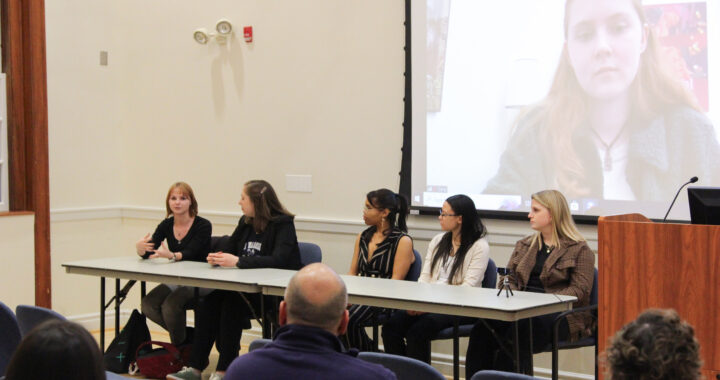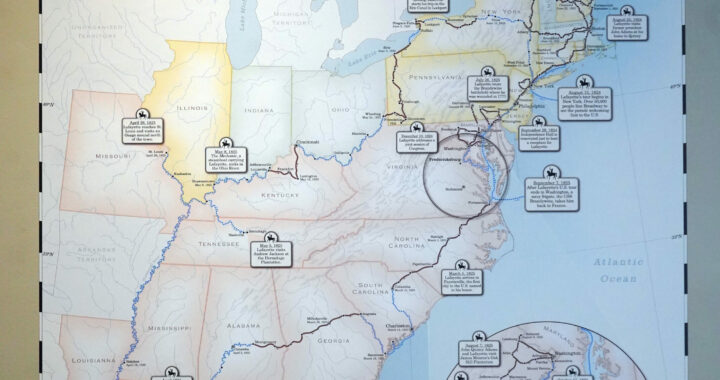Songs in the key of live
5 min readBy Emilie Begin
Harrison Roberts blows an E flat on the pitch pipe, an instrument which looks like a round harmonica that gives everyone their starting pitches. “Bv, ba bv ka.”
Senior Forrest Marquisee, the vocal percussionist, beatboxes the epic opening drum line of Phil Spector’s tune “Be My Baby,” originally performed by the Ronettes, alongside the background harmonies of the sopranos, altos, tenors and basses. Instead of Ronnie Spector on lead vocals, there’s Carly Barron, who is now a graduated psychology major from the University of Mary Washington, singing, “The night we met I knew I needed you so…” The rest of Symfonics provide vocals that sound like the instruments heard on the original track, while swaying left and right and snapping their fingers during the chorus.
Barron was a member of Symfonics for all of her four years at UMW, and last Spring, she sang her last concert. “I’m excited, but a little sad and nostalgic. I’m ready to graduate, but I’ll be sad when [the concert] is over,” she said.
The faculty/staff dining room at Seacobeck Dining Hall, located on the campus of the University of Mary Washington, was filled with chitchat and lip trill scales that Symfonics does to warm up their voices. A 24-pack of water on one of the chairs is less than half-full as the group makes sure that their vocal chords are in good shape.
It’s at this point where Roberts, a senior and the Music Director last Spring, starts thinking whether or not he has prepared everyone enough.
“We messed it up the last time we practiced it. Do we wanna run something over again, or are we going to rock this?”
Roberts has taped multiple sheets of paper on the ground that have tonight’s song order so group members don’t draw a blank when they’re supposed to be singing “Saint Simon” by the Shins, or “White Winter Hymnal” by the Fleet Foxes.
Symfonics is one of three a cappella groups at UMW. They have been around since 1991 and have released four CD’s in that time.
A cappella, though popular at UMW, seems like a mere hobby when comparing it to the scene at other schools.
A few hours away at the College of William and Mary, which only has 1500 more students than UMW, there are eleven groups and a student-run council devoted to governing these groups. William and Mary, along with James Madison University in Harrisonburg, Virginia, hold auditions for their a cappella groups the way one would rush for a fraternity or sorority, by having students and groups list their preferences, resulting in matches.
A movement that was once limited to the Ivy League schools, there are now more than 1,200 collegiate and high school a cappella groups in the country, according to a recent Boston Globe article. A cappella groups aren’t your traditional choirs whatsoever. For one thing, instead of having everyone sing the lyrics, you have one soloist while the other group members mimic instruments, using syllables such as “doo ba jin da.” The oldest college a cappella group, the Yale Whiffenpoofs, are celebrating their 100th anniversary, and while they’ve kept the traditions of singing standards and wearing suits alive, most groups have ditched the old look and cover contemporary songs. A cappella music, once limited to arch sings (which refers to the arch shape the group stands in to improve the acoustic sound) around campus and town, has experienced a move into mainstream in the last ten years.
The Globe article points out that in the last two years alone, NBC has given the greenlight on a reality television competition involving a cappella groups, titled “The Sing Off,” and GQ Magazine writer Mickey Rapkin released a book titled Pitch Perfect, sort of a Pledged for the a cappella set, which chronicled the journeys of three different a cappella groups over the course of a year. The book has recently been optioned by “30 Rock” writer Kay Cannon, in the hopes of becoming a movie.
In addition to on the screen and in print, a cappella music has achieved major record deals. Members of the original lineup of Indiana University’s Straight No Chaser signed a recording contract with Atlantic Records after their “12 Days of Christmas” video, which had been recorded at a concert during their college years, received millions of hits on YouTube.
Their debut holiday album sold 100,000 copies and was at the top of the iTunes charts last year. In addition to groups making it big, many alumni of a cappella groups are now famous, including Sara Bareilles, John Legend and Art Garfunkel.
Last April, acclaimed singer/songwriter (and recent Mary Washington visitor) Ben Folds released a new album, but he only be sang two tracks on it. Folds chose, after scouting for talent through YouTube videos, fourteen a cappella groups from various colleges, and even one high school group, to record covers of his songs. Folds got the idea for the album after seeing online videos of his songs being covered by a bunch of these groups. Ben Folds is probably the most covered artist by a cappella groups. Symfonics, in fact, did a cover of Ben Folds Five’s “Brick” last year.
With a cappella groups, there is no superior that is above everyone to keep it together, one of the reasons why an a cappella group has the feel of a fraternity or a team, something senior Matt Thorsen believes, you don’t get in a choral setting.
“I feel like as a team it’s much easier to achieve things that you and everyone else in the group really wants to achieve, while in a choir I feel like a lot of that is up to a director,” he said.
Instead of looking to just your director for an energy boost, you’re looking at your groupmates’ faces.
Senior Angela Francis sees this as one of her favorite parts of being a Symfonic.
“We look at each other and smile, because we know we sound awesome and we know the work we’ve done has paid off,” she said.
The group went over parts of a few of their tricky songs in the Faculty Dining Room while downing water bottles. The emotions in this cramped room were very mixed.
“The nerves kind of just subside once I realize how much fun the show is about to be,” senior Lauren Thorsen said.
Teams have a cheer before their games, and so do Symfonics. Minutes before the concert, they gather around in the conference room, and proceeded to do a clapping cheer, with the seniors leading. “What time is it?” The others responded with, “Game time!” Claps erupted from the audience as Bottle announced, “Please welcome Symfonics!”











